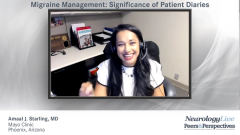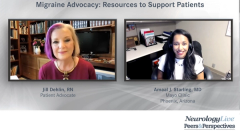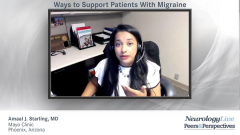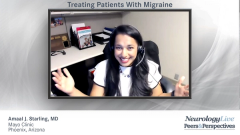
Destigmatizing Migraine: Forms of Advocacy
Examples of migraine advocacy as it pertains to health care professionals and advice for clinicians who manage patients with migraine to help address the stigma often associated with the condition.
Episodes in this series

Jill Dehlin, RN: I, myself, have experienced stigma. I’ve self-stigmatized. I didn’t really advertise the fact that I have migraine disease until I became involved in advocacy. I learned about 5 years into my journey with chronic migraine that if I didn’t advocate for myself, then nobody else was going to do it. I’m a nurse; I’m not afraid of white coats, and I know how to talk to doctors. I know the health care profession, and the system so it was sort of a light bulb moment for me that if I, a nurse, couldn’t advocate for myself to get over this self-stigma, then other people probably were having trouble with that. Can you talk a little bit next about some examples of the advocacy that people can use as it pertains to health care providers? The self-advocacy, advocating for your patients, and the institutional advocacy that I know you are very good at doing.
Amaal J. Starling, MD: For sure. Jill, first of all, thank you for being the ultimate migraine warrior. When I talk to all of my patients, I make sure that they all are aware that by living every day with the disease of migraine, they are migraine warriors. And I let people know, who treat migraine disease, that coming in to work every day, going to CME (continuing medical education), and watching videos about migraine, are also migraine warriors because we are all fighting against the disease of migraine.
Self-stigma, as you’ve identified, is that stigma that is internalized. It is so impactful, a significant barrier, and results after years, decades, and really generations of stigma of migraine. It’s just a headache, right? I’m supposed to just get over it. People will feel it is embarrassing and a reflection of being weak, unreliable, and simply not a good person, or not a good mom, or not a good employee. It is strong! I relate to what you said about being a nurse and it being surprising that you also identified that you had this stigma. It is something that is so prevalent in people that have migraine, and it results in that number 1 barrier of people talking to a healthcare provider or a physician about their symptoms. If a patient feels any pushback, any minimization from their health care provider when they get the courage to talk about their symptoms, then they’re just going to crawl back into their personal pain and not bring it up ever again. That just puts up those barriers.
So, what is it that we can do as physicians and healthcare providers to overcome self-stigma? Well, number 1, if 1 in 5 women have migraine, we as physicians are meeting 1 in 5 women patients on a daily basis. We need to acknowledge the fact that we are likely under diagnosing migraine and need to proactively investigate to see if our patients have migraine. We should not only be asking about headache days but asking about how many headache-free days people are having to try to figure out how impactful these headache days and other migraine nonheadache symptoms are in individual lives, so that we can get better at the diagnosis and then also more aggressive treatment.
The language that we also use in that appointment is also very helpful. Talking about migraine, not calling it migraine with an “s”, so not saying, you have migraines. You have 3 migraines per week. That would mean if you had 3 migraines per week, then the other 4 days you don’t have a migraine. But that’s not true. If migraine is a genetic disease, the DNA is in your body every day. It doesn’t jump in and out of your body 3 days out of the week It’s there every single day, just like asthma. We don’t tell people with asthma; they have three asthmas a week. Say that the patient says he/she has 3 asthma attacks a week. Similarly, for people who have migraine, they have migraine disease every single day of their life. They may have three migraine attacks per week, or they may have five migraine attacks per month, but they have the disease of migraine every day.
I have found that when I started using that language, not only was it helpful to legitimize the disease of migraine and validate to the patient that they have a disease. This is something that is very impactful in their life because they’ve always thought, yeah, I have headaches, but it really shouldn’t be that bad, this can’t just be migraine. There has to be something else. It has to be a tumor; it has to be MS (multiple sclerosis). No, you have migraine. It’s a genetic disease. It is highly disabling but we can treat it. And they’re like, oh, OK, I have a disease. We can treat it. I have a disease. That’s why I feel so bad, but great news, we can treat it.
The other thing that I didn’t realize when I started using this language that was really helpful was that, initially, when people thought, “I have migraine” 1 day and “I don’t have migraine” the next couple days, they thought, “Why do you want me, Dr Starling, to take a preventive medication on a daily basis when I don’t have a migraine on a daily basis?”. Teaching people that they have migraine disease every day helped me teach them that it’s important to maintain their disease with a daily preventive medication. This is similar to what is done with asthma, where some people will need a maintenance medication on a daily basis and then a rescue inhaler.
Similarly in migraine, we need a preventive medication on a daily basis and then a rescue medication for when they have an attack. Not only was using that language helpful to legitimize and validate, but it actually helped in getting buy-in in the treatment that I was recommending. It was empowering for the patient to know the specific language to use for themselves when they’re using it with their family, and their employers, and their friends.
Jill Dehlin, RN: Thank you for watching this Neurology Live Peers & Perspectives. If you enjoyed the content, please subscribe to our e-newsletters to receive upcoming programs and other great content right in your inbox.
Transcript Edited for Clarity
Newsletter
Keep your finger on the pulse of neurology—subscribe to NeurologyLive for expert interviews, new data, and breakthrough treatment updates.








































